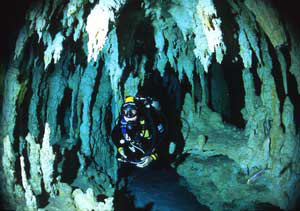 |
 |
 |
 Travel & Outdoors | July 2006 Travel & Outdoors | July 2006  
Cenote Diving In Mexico
 Niki Spence - BellaOnline Niki Spence - BellaOnline


| | One of the most beautiful is the Gran Cenote, just 4 km on the road to Cobá. This cenote is one of the most popular snorkel and diving destinations in all of the Riviera Maya. |
The Yucatan is home to some of the most beautiful natural wonders of our time, and one of the more unusual of these by far are the cenotes (say-NOH-tays) or fresh-water filled limestone sink holes. In the Yucatan there are over 3,000 cenotes, with only 1,400 actually studied and registered.

My husband and I discovered the beauty of these fascinating phenomena during our first trip to the Yucatan and I highly recommend to anyone heading to that region that you discover for yourself the captivating splendor of these miracles of nature. This is an absolute must-do for the adventure-seekers out there looking for an experience they’ll never forget.

So, what is a cenote?

The Yucatan Peninsula is a porous limestone shelf with no visible rivers; all the fresh water rivers are underground. In fact, they are quite unique in the world and were once the only source of fresh water in the Yucatecan jungle. Being porous, caverns and caves formed where the fresh water from rainfall and run-off precipitation collected – hence the cenotes or water sink holes. The water that you find here is a crystal clear turquoise color and a very pleasant temperature of 78 degrees.

Some cenotes flow out to the ocean. When the fresh water and salt water meet, a blurry halocline layer can be found. This occurrence can occur many miles inland, and is usually found at depths between 30-60 feet.

There are four different kinds of cenotes – those that are underground, those that are semi-underground, those at land level like a lake or pond, and those that are open wells, like the ones in Chichen Itza.

If you have the privilege of touring one of these amazing wonders, your next discovery will be these odd white-shaped pillars that make you feel like you’ve landed on another planet (they actually remind me of my freezer that is sadly in need of a defrosting). These incredible formations are stalactites and stalagmites and they are the formations that result from the dripping of mineral-rich water. What I found most interesting was that you couldn’t touch them with your hands because the oil on your skin actually caused irreversible damage (did you know it takes 800 years for them to grow an inch?).

So, where can one go to experience this awe-inspiring sight?

My personal experience was at Aktun Chen, in Acumal (about 130 km south of Cancun, much closer if you are staying in the Riviera Maya / Playacar region). We took a cab from our hotel to the cave buried about 3 km deep into the jungle. This was a 45 minute tour, of which about 30 minutes was spent underground walking through the former subterranean river. The group consisted of about 20 people and we all had to wear hard hats. They also had indigenous animals there, such as toucans, wild deer, monkeys and snakes. My husband got a picture taken of himself with a boa constrictor around his neck.

One of the most beautiful is the Gran Cenote, just 4 km on the road to Cobá. This cenote is one of the most popular snorkel and diving destinations in all of the Riviera Maya. Its clear water allows swimmers and divers to see the underwater cave formations and the small fish that live there. Gran Cenote is perfect for everyone, young and old. Even if you aren’t a diver, the snorkeling here is also spectacular.

Cenote Calavera is located about one kilometer before the Gran Cenote, down small, marked path into the jungle (you will see a sign along the highway). Its three holes form the skull shape which gave the cenote its name. This is a beautiful place to jump into the water from ten feet above. However, be warned that getting out can be a challenge and many use an existing tree branch or they bring a rope.

Farther up on the highway to Cancun and Playa del Carmen is Cenote Dos Ojos, whose two holes make an excellent place to swim or dive. Cenote Escondido is another popular cenote located south of Tulum, on the road to Carrillo Puerto and Chetumal, just five minutes from Tulum.

Finally, if you are not quite that adventurous but would love to see and experience a little piece of this heaven, visit this great restaurant in Playa del Carmen… 1001 Aluxes is one of the latest hot spots in Playa del Carmen. Enter this underground oasis through the cave entrance, descend down a stone stairway and prepared for dining, dancing and cave dwelling all under one rock formation. | 
 | |
 |



